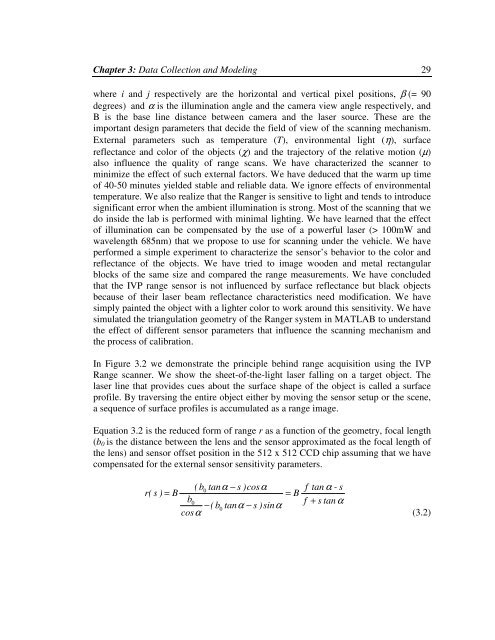To the Graduate Council: I am submitting herewith a thesis written by ...
To the Graduate Council: I am submitting herewith a thesis written by ...
To the Graduate Council: I am submitting herewith a thesis written by ...
Create successful ePaper yourself
Turn your PDF publications into a flip-book with our unique Google optimized e-Paper software.
Chapter 3: Data Collection and Modeling 29where i and j respectively are <strong>the</strong> horizontal and vertical pixel positions, β (= 90degrees) and α is <strong>the</strong> illumination angle and <strong>the</strong> c<strong>am</strong>era view angle respectively, andB is <strong>the</strong> base line distance between c<strong>am</strong>era and <strong>the</strong> laser source. These are <strong>the</strong>important design par<strong>am</strong>eters that decide <strong>the</strong> field of view of <strong>the</strong> scanning mechanism.External par<strong>am</strong>eters such as temperature (T), environmental light (η), surfacereflectance and color of <strong>the</strong> objects (χ) and <strong>the</strong> trajectory of <strong>the</strong> relative motion (µ)also influence <strong>the</strong> quality of range scans. We have characterized <strong>the</strong> scanner tominimize <strong>the</strong> effect of such external factors. We have deduced that <strong>the</strong> warm up timeof 40-50 minutes yielded stable and reliable data. We ignore effects of environmentaltemperature. We also realize that <strong>the</strong> Ranger is sensitive to light and tends to introducesignificant error when <strong>the</strong> <strong>am</strong>bient illumination is strong. Most of <strong>the</strong> scanning that wedo inside <strong>the</strong> lab is performed with minimal lighting. We have learned that <strong>the</strong> effectof illumination can be compensated <strong>by</strong> <strong>the</strong> use of a powerful laser (> 100mW andwavelength 685nm) that we propose to use for scanning under <strong>the</strong> vehicle. We haveperformed a simple experiment to characterize <strong>the</strong> sensor’s behavior to <strong>the</strong> color andreflectance of <strong>the</strong> objects. We have tried to image wooden and metal rectangularblocks of <strong>the</strong> s<strong>am</strong>e size and compared <strong>the</strong> range measurements. We have concludedthat <strong>the</strong> IVP range sensor is not influenced <strong>by</strong> surface reflectance but black objectsbecause of <strong>the</strong>ir laser be<strong>am</strong> reflectance characteristics need modification. We havesimply painted <strong>the</strong> object with a lighter color to work around this sensitivity. We havesimulated <strong>the</strong> triangulation geometry of <strong>the</strong> Ranger system in MATLAB to understand<strong>the</strong> effect of different sensor par<strong>am</strong>eters that influence <strong>the</strong> scanning mechanism and<strong>the</strong> process of calibration.In Figure 3.2 we demonstrate <strong>the</strong> principle behind range acquisition using <strong>the</strong> IVPRange scanner. We show <strong>the</strong> sheet-of-<strong>the</strong>-light laser falling on a target object. Thelaser line that provides cues about <strong>the</strong> surface shape of <strong>the</strong> object is called a surfaceprofile. By traversing <strong>the</strong> entire object ei<strong>the</strong>r <strong>by</strong> moving <strong>the</strong> sensor setup or <strong>the</strong> scene,a sequence of surface profiles is accumulated as a range image.Equation 3.2 is <strong>the</strong> reduced form of range r as a function of <strong>the</strong> geometry, focal length(b 0 is <strong>the</strong> distance between <strong>the</strong> lens and <strong>the</strong> sensor approximated as <strong>the</strong> focal length of<strong>the</strong> lens) and sensor offset position in <strong>the</strong> 512 x 512 CCD chip assuming that we havecompensated for <strong>the</strong> external sensor sensitivity par<strong>am</strong>eters.r( s )( b0tanα− s )cosα= B= Bb0−( b0tanα− s )sinαcosαf tan α - sf + s tanα(3.2)
















